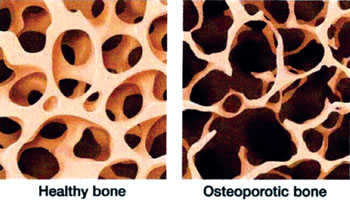Bone Turnover Marker Concentrations for Osteoporosis Reviewed
By LabMedica International staff writers
Posted on 17 Aug 2016
Current evidence continues to support the potential for bone turnover markers (BTM) to provide clinically useful information particularly for monitoring the efficacy of osteoporosis treatment.Posted on 17 Aug 2016
Many of the limitations identified earlier remain, principally in regard to the relationship between BTM and incident fractures. Important data are now available on reference interval values for C-terminal telopeptide (CTX) and procollagen type I propeptides (PINP) across a range of geographic regions and for individual clinical assays.

Image: The difference between normal and osteoporotic spongy bone can be seen (Photo courtesy of Mark A. Wolgin, MD).
A team of international scientists led by those at the University of South Australia (Adelaide, Australia) have reviewed CTX and PINP data and found an apparent lack of comparability between current clinical assays for CTX has become evident indicating the possible limitations of combining such data for meta-analyses. Harmonization of units for reporting serum/plasma CTX (ng/L) and PINP (μg/L) is recommended.
Osteoporosis, which literally means porous bone, is a disease in which the density and quality of bone are reduced. As bones become more porous and fragile, the risk of fracture is greatly increased. The loss of bone occurs silently and progressively. Often there are no symptoms until the first fracture occurs. Around the world, one in three women and one in five men are at risk of an osteoporotic fracture. In fact, an osteoporotic fracture is estimated to occur every three seconds. The most common fractures associated with osteoporosis occur at the hip, spine and wrist. The likelihood of these fractures occurring, particularly at the hip and spine, increases with age in both women and men.
The development of international collaborations continues with an important initiative to combine BTM results from clinical trials in osteoporosis in a meta-analysis and an assay harmonization program are likely to be beneficial. It is possible that knowledge derived from clinical studies can further enhance fracture risk estimation tools with inclusion of BTM together with other independent risk factors. Further data of the relationships between the clinical assays for CTX and PINP as well as physiological and pre-analytical factors contributing to variability in BTM concentrations are required. The study was published on June 30, 2016, in the journal Clinica Chimica Acta.
Related Links:
University of South Australia









 assay.jpg)



